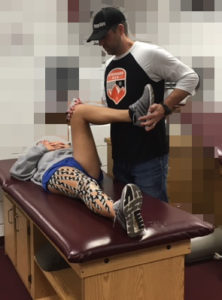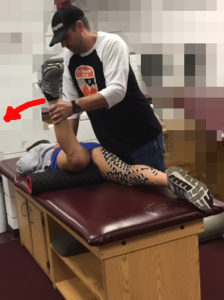by Mitch Hauschildt, MA, ATC, CSCS
It doesn’t take a genius to figure out that low back pain is a huge issue and affects the majority of Americans at some point in their lives. One discouraging fact about low back pain is that despite our best efforts and all of the medical advances in therapies, the rates of low back pain continue to rise.
You may be wondering why…
There are likely a lot of answers, including the fact that I don’t know that really have a great understanding of this area of the body, including the SI joint. Also, we continue to learn more and more about the complicated subject that is pain science. Obesity rates continue to rise. And, despite the best efforts of gyms, personal trainers, therapists, and Crossfit, as a whole, we continue to be less and less active as a society.
One strong correlation that I keep coming across with my patients with low back pain is poor hip internal rotation (IR). I will admit that for many years I don’t ever recall assessing hip internal rotation when I was performing an evaluation for low back pain. At the end of the day, I think it leads me back down the road of my complete under appreciation of transverse plane motion and its affect on the things we do every day. We like to train people in the frontal and sagittal plane, but forget about all things rotational.
A few years ago I began assessing hip internal rotation out of curiosity and what interested me immediately was that virtually every one of my patients who presented with low back pain had a restriction in passive hip IR on at least one side.
As is the case with all of my therapy, once I find dysfunction, I better fix it. And, sure enough, as soon as I began to address this area of dysfunction, their low back pain improved. Recently, I did a quick Google search on the subject, and found that there is at least some research out there that does support this clinical observation. I have listed a few citations below. After looking through the research, there is limited, high quality research that supports it, especially in recent years, but there are at least a few people who have examined it. But, no one attempts to explain the relationship.
Why does this correlation exist?
H0w do I explain the mechanics of what is going on when I find a hip IR restriction with my low back patient? After a lot of thought, I’m not sure I’m smart enough to fully explain it. I did come across a brief theory presented by Dan Lorenz in a blog post he published on Mike Reinold’s site, but he also didn’t have a definitive answer. You can read his full article here.
 His basic theory as I understand it is that if there is a lack of hip IR, the pelvis isn’t allowed to fully rotate over top of the stance limb during gain which limits the coupling mechanics of the joint. Further, this position may also hinder the normal length tension relationship of the Multifidus, an important trunk and lumbar spine stabilizer.
His basic theory as I understand it is that if there is a lack of hip IR, the pelvis isn’t allowed to fully rotate over top of the stance limb during gain which limits the coupling mechanics of the joint. Further, this position may also hinder the normal length tension relationship of the Multifidus, an important trunk and lumbar spine stabilizer.
All in all, I can’t seem to fully wrap my head around exactly how or why this correlation exists. But, I am smart enough to recognize it and go after it. Again, we want to perform a full body evaluation when someone comes to us for the first time. When we find dysfunction, regardless of where it is or what it is, we need to fix it, even if it appears to have very little to no bearing on the issue at hand.
The next part of this discussion is, how do we fix it? I’m not going to take the time to go into that in this post, but I do want to bring it up to get the wheels turning for a lot of you. The major question that we may want to ask with someone who has a hip IR restriction is whether it is muscular or capsular in nature.
Defining this is also easier said than done, but a muscular restriction will respond well to cyclic stretching while a capsular restriction will typically do better with joint mobilizations of some sort. I’ll leave more on this part of the discussion to another post for another day. I just encourage you to think through what type and where such a restriction may be coming from to know how to best respond to it.
The next time someone comes in with low back pain, make sure you check their hip internal rotation passively, actively and in different postural positions to make sure you get a good idea what is going on so you can address it appropriately. I think you will find that this restriction is more prevalent that you realize.
- Porterfield JA, DeRosa C. Mechanical low back pain: Perspectives in functional anatomy. 2nd ed. Philadelphia: WB Saunders, 1998.
- Ellison JB, Rose SJ, Sahrmann SA. Patterns of hip rotation range of motion: a comparison between healthy subjects and patients with low back pain. Phys Ther. 1990; 70(9): 537-541.
- Chesworth BM, Padfield BJ, Helewa A, et al. A comparison of hip mobility in patients with low back pain and matched healthy subjects. Physiotherapy Canada. 1994; 46: 267-74.
- Mellin G. Correlation of hip mobility with degree of back pain and lumbar spinal mobility in chronic low back pain patients. Spine. 1988; 13: 668-670.
- Vad VB, Bhat AL, Basrai D, et al. Low back pain in professional golfers: the role of associated hip and low back range of motion deficits. Am J Sports Med. 2004; 32(2): 494-497.
- Batt ME. Golfig injuries: an overview. Sports Med. 1993; 16: 64-71.
- Cibulka MT, Sinacore DR, Cromer GS, Delitto A. Unilateral hip rotation range of motion asymmetry in patients with sacroiliac joint regional pain. Spine. 1998; 23: 1009-1015.
- Cibulka MT. The treatment of the sacroiliac component to low back pain: a case report. Phys Ther. 1992; 72: 917-922.
- Warren PH. Management of a patient with sacroiliac joint dysfunction: a correlation of hip range of motion asymmetry with sitting and standing postural habits. J Man Manip Ther. 2003; 11: 153-159.


I m doing college project on Hip Internal rotation mobilization for low back pain. But still the Exact reason why the hip IR is restricted in low back pain is not been found. Can u pls help me with it.